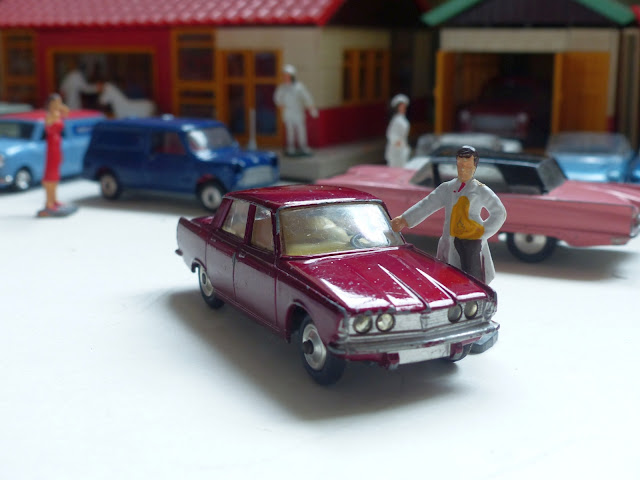Economies at Corgi must have spread to the budget for cover designers as the 1974 Corgi catalogue has the same image back and front!
It's a JPS Lotus and racing cars certainly get well-featured again. However, returning for the first time since 1966, are military models with the very first two pages taking us right on to two shades of desert sand with the new Gift Set 10, the Mack cab pulling a familiar machinery carrier. Yes it is 1135 with a Phillips screw where the capstan, winch or spare tyres used to be. It's carrying a Centurion Tank which just fits. There are also tanks from America and Germany - all three made in Hong Kong. I may be wrong but I think these are the first Corgi models made abroad.
Next there is the new and enormous JPS Lotus in 1:18 scale. Clearly marked as 1:36 scale now are the other racing cars in an extended range, as are the pages of a few sports cars now available in that size.
On the 1:43 pages many of the previous years have now gone. In 1973 there were over 50 Whizzwheels motor car models. Now there are about 30. Some of the worst remain, such as the ridiculous Starfighter Dragster which was 'Available Later' and now is 169 Starfighter Jet Car with what looks like completely redesigned body and decals.
The one interesting new addition is the 400 VW Driving School Car. It is illustrated in 256 red-orange rather than the metallic blue is actually appeared in.
The Gift Set 19 Land Rover and trailer are now blue as issued.
Planes have doubled to cover eight pages now.
There are two absolutely awful new models on a page designated as 'Fast transport'. They are 700 Motorway service Ambulance and 701 Inter-City Mini-Bus. I think the fact these these dreadful things are quite easy to find at about £2 in good condition and £20 as new in a box sums up suitably what most people thought (and still think) of these models. I would have fired the bloke who came up with them in the first place! But it was the 1970s, I suppose, and Sweet and Slade led the fashion scene.
In complete contrast, 477 finally gets Whizzwheels in this catalogue but has a very ugly knob attached at the side in the model used for illustration which appears to ahve been borrowed from a crane.


An enormous Crane Fruehauf Discharge Dumper with a Berliet Cab unit is another new item. This does not look very nice at all and takes over the 1102 catalogue number. It looks as if it is in the scale I need to document, however, so I guess I shall have to get one. Corgi did a lot of models that might have been useful in the garden for youngsters in 1974. As well as that massive Dumper above which could take several sticks of rhubarb, there were now several Unimogs, a roller thing, a dumper truck and three cranes! (A Priestman Boom Crane, a Cub Shovel and a Priestman Crane Truck).
Down on the farm, Gift Set No. 4 is new. It is the one that has the two retarded village kids sitting on a pile of hay, on a trailer drawn by the new Massey Ferguson 50B tractor. The set is shown as including fences and animals. I am trying to get hold of one of these but they're expensive now and pretty darn scarce.

In the London Gift Set the taxi now has a distinctive purple tinge and the 204 Mini is metallic blue.
The Lions of Longleat are still going strong in 1974, although the Landrover shown is still an old one with shaped wheels. So too are the Batmobile and BatBoat and the 270 James Bond Aston Martin (still shown with tyre slashers).
After all the big launch of the Magic Roundabout sets over four pages in 1973, all we get in 1974 is Dougal's Car and Mr McHenry's Trike and Zebedee. In place of all the others there is a very cheap and nasty looking Dick Dastardly Racing Car and I am most definitely not going to try and get hold of one of those in a hurry!

Finally, Gift Set 7 gets revised with a Whizzwheels Land Rover at last and a new black 'rainbow' box.
Unless you were into racing cars, planes or gardening, there really was not much that Corgi had to offer to inspire collectors in 1974.




























